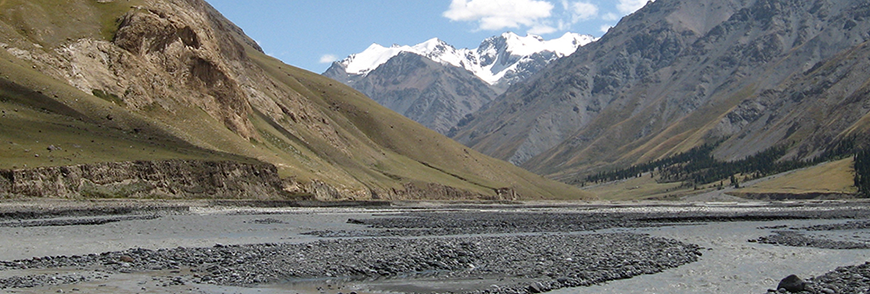17.08.2016: The Tarim Basin in Northwest China is a region characterized by an extremely arid climate. Its population – more than ten million people – is supplied with fresh water by the Tarim, the region’s main river. The river is largely fed from the surrounding glaciated mountain regions. Knowledge on the impact of future climate change on the glaciers and rivers of these mountain areas therefore is of great importance for regional water supply.
A study by scientists from the GFZ, the Potsdam Institute for Climate Impact Research PIK, and the China Meteorological Administration CMA now shows projections for the future evolution of water balance of the Aksu River, the most important tributary of the Tarim. For the first time changes in glacier areas are taken into account. “Since a large part of the river water is fed by glacier melt, simulations with constant glacier areas would lead to wrong conclusions”, Doris Düthmann explains. She is main author of the study, former GFZ, section Hydrology, and now working at the Technical University of Vienna, Austria.
For the study, published in Environmental Research Letters, discharge data over the past 50 years and satellite data of the observed glacier mass loss are used. The calculations are based on different model simulations that consider several emission scenarios, climate models, and parameters of the hydrological model. Like this, the scientists obtain a range of projections.
Major challenges for regional water supply
The simulations show a drastic decrease of glacier areas of 32 to 90 percent by the end of the century, compared to 2008. Accordingly, higher temperatures and an increased glacier melt at the beginning of the 21st century lead to an increased glacier runoff and a thereby increased water availability. However, over the course of the 21st century reduced glacier areas result in declining glacier melt and water availability from the mountain catchments.
“These projections are urgently needed for land use and water management”, says Doris Düthmann, „One should not be misled by the currently observed trends.“ The increase in irrigation areas and water extraction over the last decades already results in problems in the downstream areas. Water levels decline and stretches of the river bed dry out – despite currently increasing runoff from the mountain areas. “The region will face enormous challenges if the water resources from the mountain areas are declining in the future.” (ak)
Duethmann, D., Menz, C., Jiang, T., Vorogushyn, S. 2016. Projections for headwater catchments of the Tarim River reveal glacier retreat and decreasing surface water availability but uncertainties are large. Environmental Research Letters, 11, 13 p, doi:10.1088/1748-9326/11/5/054024








![[Translate to English:] Torsten Sachs in front of a climate station on a field](/fileadmin/_processed_/3/9/csm__TorstenSachs_bearbeitet_GS_4a1365ef84.jpeg)

![[Translate to English:] left image flood at the Ahrtal: image from above, several houses are flooded; left image:: Heidi Kreibich;](/fileadmin/_processed_/4/4/csm_Bild2_9af0130e9f.png)



![[Translate to English:] Start der Vega Rakete](/fileadmin/_processed_/6/4/csm_20231201-kachel_Vega-VV23-launch_ESA-CNES-Arianespace_706716b68c.jpeg)









![[Translate to English:] Poster exhibition at the Brandenburg Hydrogen Day at the GFZ, some participants in the foreground](/fileadmin/_processed_/6/5/csm_Erster_Brandenburgischer_Wasserstofftag_GFZ_402fcec95e.jpeg)
![[Translate to English:] Group picture of the participants](/fileadmin/_processed_/9/4/csm_20231108_CAWa-Workshop-Tashkent_Gruppenbild_99ea779d8a.jpeg)

![[Translate to English:] [Translate to English:] Hörsaal](/fileadmin/_processed_/e/6/csm_H%C3%B6rsal_e21ac645fb.jpeg)


![[Translate to English:] The Delegations in the Historic Library on the Telegrafenberg. In the back there are from left to right, the Dutch Ambassador for Germany, Ronald van Roeden, the Dutch Minister for Education, Culture and Science, Robbert Dijkgraaf and the scientific director of the GFZ, Susanne Buiter.](/fileadmin/_processed_/d/b/csm_Kachel-2_9eba4b4212.jpeg)

